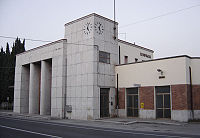
Roberto Narducci
Encyclopedia


Modern architecture
Modern architecture is generally characterized by simplification of form and creation of ornament from the structure and theme of the building. It is a term applied to an overarching movement, with its exact definition and scope varying widely...
and Novocento
Novecento Italiano
Novecento Italiano was an Italian artistic movement founded in Milan in 1922 by Anselmo Bucci , Leonardo Dudreville , Achille Funi, Gian Emilio Malerba , Piero Marussig, Ubaldo Oppi and Mario Sironi...
movements.
Life
Narducci was born in Rome on August 14, 1887 into a middle class family. After receiving his technical 'licenzia' in 1903-04, he obtained a diploma in architectural decoration from the Arts and Industry Museum of Rome in 1909. In the same year he won a competition to become a designer for the Italian state railway company, Ferrovie dello StatoFerrovie dello Stato
Ferrovie dello Stato is a government-owned holding which manage infrastructure and service on the Italian rail network. The subsidiary Trenitalia is the main rail operator in Italy.-Organization:Ferrovie dello Stato subsidiaries are:...
.
From 1920-21 he enrolled in the three year program at the Regia Scuola Superiori di Architettura, and from there he received his degree
Academic degree
An academic degree is a position and title within a college or university that is usually awarded in recognition of the recipient having either satisfactorily completed a prescribed course of study or having conducted a scholarly endeavour deemed worthy of his or her admission to the degree...
in Civil Architecture in 1923. In 1930 passed the qualification examination to become a practicing professional engineer
Engineer
An engineer is a professional practitioner of engineering, concerned with applying scientific knowledge, mathematics and ingenuity to develop solutions for technical problems. Engineers design materials, structures, machines and systems while considering the limitations imposed by practicality,...
.
In his lifetime, working under the Ministry of Communications
Ministry of Communications (Italy)
The Ministry of Communications was a government ministry of the Republic of Italy, dealing with postal, telephone, telegraph and electronic communications, journalistic information and commercial advertising. Set up in 1924, since the Berlusconi IV Cabinet of 2008 it has been subsumed into the...
(now within the Ministry of Transport) he designed approximately 40 railway stations, both new buildings and post-war
Post-war
A post-war period or postwar period is the interval immediately following the ending of a war and enduring as long as war does not resume. A post-war period can become an interwar period or interbellum when a war between the same parties resumes at a later date...
reconstructions and about ten Post Offices. He frequently worked with his colleague Angiolo Mazzoni
Angiolo Mazzoni
Angiolo Mazzoni was a prolific state architect and engineer of the Italian Fascist government of the 1920s and 1930s.Mazzoni designed hundreds of public buildings, post offices and train stations during the Interwar period in Italy...
.
Structures
Buildings- Palazzo delle Poste e Telegrafi di Bari, 1931 plan
- Palazzo delle Poste e Telegrafi di Rovigo, 1927-1930
Railway stations
- Albenga railway station, 1930
- Battipaglia railway station, 1930
- Levanto railway station
- Loano railway station plan
- Santa FlaviaSanta FlaviaSanta Flavia is a town in the province of Palermo, Sicily, southern Italy.-Overview:The town is situated between the Gulf of Palermo and the town and hot springs known as Termini Imerese, on the Tyrrhenian Sea, 15 km east of Palermo...
railway station, 1932 - Redipuglia railway station, 1936
- Roma Ostiense railway stationRoma Ostiense railway stationRoma Ostiense is a train station in Piazza dei Partigiani serving the Ostiense district of Rome, Italy, a short distance from the Porta San Paolo. It is run by the Centostazioni arm of the Ferrovie dello Stato group and the urban rail lines FR1, FR3, and FR5 run through the station...
, 1940 - Ventimiglia railway stationVentimiglia railway stationVentimiglia railway station is the main station of the Italian city of Ventimiglia. It is at the end of three rail routes: the Genoa–Ventimiglia line, the Cuneo–Ventimiglia line and the Marseille–Ventimiglia line. It plays an important role not only in rail transport in Liguria, but also in Italy...
- Verona Porta Nuova railway station
- Viareggio railway stationViareggio railway stationViareggio railway station serves the city and comune of Viareggio, in the region of Tuscany, central Italy. Opened in 1936, it forms part of the Pisa–La Spezia–Genoa railway, and is also a junction for a secondary line to Lucca....

